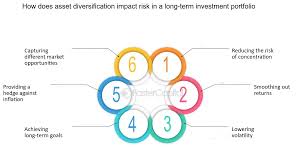Investing for the long term is a cornerstone of building wealth and achieving financial stability. As we step into 2024, it’s essential to adapt investment strategies to align with current market trends and economic conditions. Long-term investing involves buying and holding investments over an extended period, allowing them to grow and compound. This approach helps mitigate short-term market volatility and capitalize on the long-term growth potential of assets. This guide will explore effective long-term investing strategies for 2024, focusing on diversification, emerging trends, and prudent risk management.
1. Diversification: The Bedrock of Long-Term Investing

Diversification is a fundamental principle of investing, reducing risk by spreading investments across various asset classes. For 2024, diversification remains crucial to mitigate market risks and enhance the potential for returns. Here’s how to diversify effectively:
- Asset Classes: Allocate investments across different asset classes such as stocks, bonds, real estate, and commodities. This distribution helps protect your portfolio from significant losses in any single asset class.
- Geographic Diversification: Invest in international markets to gain exposure to different economies and regions. Global diversification can reduce the impact of regional economic downturns and provide access to growth opportunities in emerging markets.
- Sector Diversification: Avoid concentrating investments in a single sector. Spread investments across various industries to safeguard against sector-specific downturns.
2. Embrace Sustainable and ESG Investing
Environmental, Social, and Governance (ESG) investing focuses on companies that adhere to ethical and sustainable practices. In 2024, ESG investing is gaining momentum as investors increasingly prioritize sustainability and corporate responsibility.
- Environmental Impact: Invest in companies that prioritize environmental sustainability, such as those involved in renewable energy, clean technology, and waste reduction.
- Social Responsibility: Consider companies that demonstrate strong social values, including fair labor practices, community involvement, and diversity and inclusion initiatives.
- Governance: Look for companies with transparent and ethical governance practices, including strong leadership, accountability, and compliance with regulations.
3. Leverage Technology and Innovation
Technology continues to drive innovation and reshape industries. Investing in technology and innovative sectors can provide significant growth potential over the long term.
- Tech Stocks: Consider investing in established technology companies as well as emerging tech startups with disruptive innovations. Sectors such as artificial intelligence, cybersecurity, and cloud computing offer substantial growth opportunities.
- Innovation Funds: Explore funds and ETFs focused on technology and innovation. These funds often invest in a diversified portfolio of tech-related companies, providing exposure to cutting-edge developments.
- Research and Development: Invest in companies that prioritize research and development (R&D). Firms committed to innovation are likely to lead in their respective industries and deliver long-term value.
4. Focus on Dividend Growth Stocks
Dividend growth stocks are shares in companies that regularly increase their dividend payments. These stocks can provide a steady income stream and potential for capital appreciation.
- Stable Dividends: Look for companies with a history of stable and growing dividends. These firms often have strong financials and reliable cash flow.
- Reinvestment: Consider reinvesting dividends to purchase additional shares, which can enhance compound growth over time.
- Dividend Aristocrats: Invest in Dividend Aristocrats, companies that have consistently increased dividends for 25 years or more. These companies are known for their financial stability and commitment to returning value to shareholders.
5. Consider Real Estate Investments

Real estate can be a valuable component of a long-term investment strategy. It offers diversification, income potential, and long-term appreciation.
- Rental Properties: Investing in rental properties can provide a steady income stream and potential for property value appreciation. Look for properties in high-demand areas with strong rental yields.
- Real Estate Investment Trusts (REITs): REITs offer a way to invest in real estate without owning physical properties. They provide exposure to various real estate sectors and often pay dividends.
- Real Estate Crowdfunding: Explore real estate crowdfunding platforms that allow you to invest in commercial and residential properties with relatively low capital requirements.
6. Adopt a Long-Term Mindset
A long-term investment strategy requires patience and discipline. Here’s how to maintain a long-term mindset:
- Avoid Market Timing: Resist the urge to time the market based on short-term fluctuations. Focus on your long-term investment goals rather than reacting to market noise.
- Regular Contributions: Make regular contributions to your investment portfolio, even during market downturns. Consistent investing helps smooth out market volatility and builds wealth over time.
- Rebalance Periodically: Review and rebalance your portfolio periodically to ensure it aligns with your long-term goals and risk tolerance. Rebalancing helps maintain your desired asset allocation and manage risk.
7. Explore Alternative Investments
Alternative investments can offer diversification and potential for higher returns, but they come with unique risks and considerations.
- Private Equity: Invest in private equity funds that focus on early-stage companies or buyouts. These investments can offer substantial returns but may have higher risks and longer holding periods.
- Hedge Funds: Consider hedge funds that employ various strategies to achieve returns in different market conditions. Hedge funds can provide diversification but often require higher minimum investments and fees.
- Commodities: Invest in commodities such as gold, silver, or oil. Commodities can act as a hedge against inflation and provide diversification benefits.
8. Stay Informed and Educated
Ongoing education and staying informed about market trends are crucial for successful long-term investing.
- Market Research: Regularly read financial news, research reports, and market analyses. Staying informed about economic conditions and market trends helps you make informed investment decisions.
- Financial Education: Invest in your financial education by attending seminars, taking courses, and reading books about investing and personal finance.
- Consult Financial Advisors: Consider consulting with financial advisors or investment professionals to gain personalized insights and guidance based on your specific financial goals and situation.
9. Manage Risks Effectively
Risk management is essential for protecting your investments and achieving long-term success.
- Risk Tolerance: Assess your risk tolerance and invest accordingly. Understand your capacity to handle market fluctuations and align your investments with your risk profile.
- Emergency Fund: Maintain an emergency fund with sufficient liquidity to cover unexpected expenses. An emergency fund helps you avoid having to sell investments in unfavorable market conditions.
- Insurance: Consider insurance products such as life insurance and disability insurance to protect your financial well-being and investment portfolio.
10. Evaluate and Adjust Strategies

Long-term investing requires periodic evaluation and adjustment of strategies based on changing circumstances.
- Performance Review: Regularly review the performance of your investments and assess whether they are meeting your long-term goals. Make adjustments as needed to stay on track.
- Life Changes: Adjust your investment strategy in response to significant life changes such as retirement, major purchases, or changes in income. Ensure your investments align with your evolving financial needs and goals.
Conclusion
Long-term investing strategies for 2024 emphasize diversification, sustainability, and the embrace of technological and innovative trends. By adopting a diversified approach, focusing on sustainable and ESG investments, leveraging technology, and considering alternative investments, you can build a robust and resilient portfolio. Maintaining a long-term mindset, managing risks effectively, and staying informed are key to achieving financial success over time. As you navigate the investment landscape in 2024, these strategies will help you create a strong foundation for wealth accumulation and financial stability.


